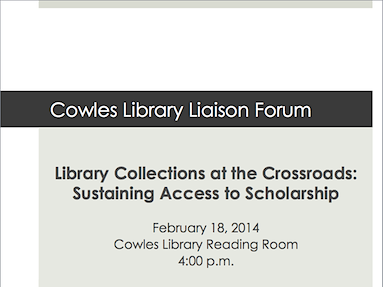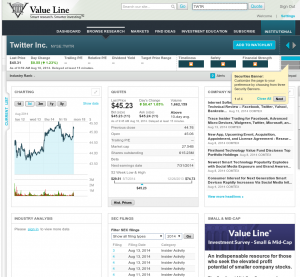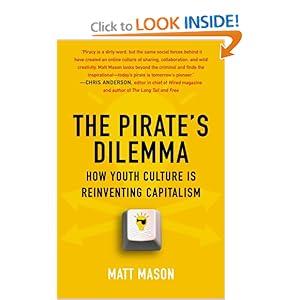
For those of you who missed it, below are the slides from the presentations, and a link to the online survey.
Other links of interest:
BACKGROUND INFORMATION: Below is a reading that attendees may find useful. Also, it’s important to note that collaborative discussions and projects concerning Cowles Library’s physical collections are already underway. The most important ongoing project is CI-CCI (Central Iowa Collections Initiative). More detail will be provided at the meeting.
We also encourage attendees to peruse the following short reading:
From Stacks to the Web: the Transformation of Academic Library Collecting
Suggested Reading for an open Cowles Library Liaison Meeting
NOTE: The following is a condensed version of an article published in January 2013 in College and Research Libraries. The condensation was done by Prof. Bruce Gilbert (local editorial comments are in italics and underlined), and all errors and opinions are his. The full text of this article is available here: http://crl.acrl.org/content/early/2012/01/09/crl-309.full.pdf+html
SECOND NOTE: The purpose of this condensation is not to imply agreement with most, or all, of its tenets by Cowles Library Faculty. Rather, it is to provide background for what we hope will be a robust discussion among all Drake faculty on the future of the Library and its collections.
Official Abstract:
The existence of a ubiquitous and cheap worldwide communication’s network that increasingly makes documents easily and freely available will require a transformation of academic library collecting practice. It will be driven by a number of specific developments including: the digitization of content; the development of print repositories; the development of e-readers and print-ondemand publishing; the growth of open access; challenges to establish academic publishing organizations; and the growth of new forms of scholarship based on openness and social productivity. If academic libraries are to be successful, they will need to: deconstruct legacy print collections; move from item-by-item book selection to purchase-on-demand and subscriptions; manage the transition to open access journals; focus on curating unique items; and develop new mechanisms for funding national infrastructure.
Condensed version:
I. Assumptions:
The assumption of this article is that library collections (books, journals, etc.) are undergoing radical change, and this change will profoundly affect libraries and their users. “The fundamental force for change is the growth of computing power and its application to create a ubiquitous and cheap worldwide communications network. This network contains a large and growing amount of content.” “Libraries will soon be able to provide much of the information required by their communities without resorting to local print collections.” (Ed. note: This has already happened at Cowles; we have tens of thousands of electronic magazines and journals, for example, and only a few hundred current print subscriptions)
II. Brief History and background:
Twenty years ago, Michael Buckland published Redesigning Library Services: A Manifesto. Buckland divided library history into three eras: the Paper Library,where both bibliographic tools and documents were in paper; the Automated Library, where the bibliographic tools were digital, but the documents were still paper, and the Electronic Library, were both bibliographic tools and documents are digital. Importantly, Buckland recognized that the significant transition was not from Paper Library to Automated Library because the change in bibliographic tools did not fundamentally alter library practice. Readers still had to come to libraries to get and use documents. Buckland recognized that only when both bibliographic tools and documents become digital would fundamental change occur.
- Buckland begins by defining the purpose of libraries as providing access to information, usually through the provision of documents to readers. He notes that collections have two roles: the preservation role, and the dispensing role. As he states, in the paper and automated libraries, “The principle reason for most investment in collections development is not preservation but the need to provide convenient access to materials that people want to see where they want to see them”
- Digital documents are not physically constrained. Many readers located in many places can use a digital document simultaneously.
- Buckland points out that the dispensing function accounts for the “the great preponderance of operating costs and space needs in the Paper Library and in the Automated Library.” Most of the cost of collections is for large quantities of relatively little-used material. Buckland also reflects on the symbolic role of library collections, how large paper collections provide institutions with status and prestige, and he wonders whether access to digital documents will prove to have similar symbolic value. Lastly, Buckland observes that digital documents should lead to a national rather than a local focus for collection building.
Others have argued that it is important to consider not what libraries do, but rather what they are for. One answer is that libraries are the means that communities and organizations use to provide information subsidy. Subsidy is important because institutions and communities recognize that left to their own devices individuals will not and cannot acquire and use all the information they need to be fully productive. Institutional or community subsidy is thus justified in order to create libraries as a common good.
Specific Drivers of Change for Libraries and Scholarly Communication
1. Digitization of Content
The Google Books project was the impetus for two other important mass digitization projects, the Internet Archive’s Ebook and Texts Archive containing over 2 million public domain titles and the HathiTrust, a collaborative program of over 50 academic and research libraries that contains nearly 9 million volumes, much of it copies of Google and Internet Archive scans. A study by Constance Malpas found that as of June 2010 the median rate of duplication between titles held by members of the Association of Research Libraries (ARL) and the HathiTrust was 30%, and it is projected to be more than 60% by June of 2014.
It seems likely that sooner or later most of the books in existence will be scanned. It is then only a matter of time before lawyers, the
courts, Congress, or more likely some combination of the above, will find a compromise to make at least some significant portion of them available to individuals and libraries. Libraries are likely to remain the payment mechanism for some of the access. It is also easy to imagine an iTunes-like model for individual purchases.
2. Print Repositories
The potential efficiencies of a coordinated group of print repositories with a service that provides print copies of works to libraries is significant. Present values for perpetual storage per book are calculated at: $142 for open stacks is $141.89 and $29 for high-density storage is $28.77. If a robust shared print service were in place today, the median space saving for an ARL library would be 45,000 assignable square feet. The cost avoidance if a shared print service for mass-digitized books were available today would be between $500,000 and $2 million per ARL library. (Ed. note: Cowles Library is already engaged in a project to share print collections with other Central Iowa Libraries.)
3. E-Book Readers and Print on Demand
In May 2011, Amazon sold more e-books than print books. It is clear that e-books and e-book readers have become an important part of the mainstream market for books. With the development of digital printing processes, it became possible to reduce print runs significantly, finally allowing printing to be done one item at a time. The ultimate expression of print-on-demand (POD) may be the Espresso Book Machine (EBM). An EBM costs a bit more than $100,000 depending on the printer with which it is paired and can print and bind books for a penny a page.
4. Open Access Publishing
As defined by Peter Suber, “Open-access (OA) literature is digital, online, free of charge, and free of most copyright and licensing restrictions. OA removes price barriers (subscriptions, licensing fees, pay-per-view fees) and permission barriers (most copyright and licensing restrictions).”
Open access began in the early 1990s and has grown at a faster rate than the scholarly literature generally. In 2004 the DOAJ listed 1,133 titles and by November of 2011 that number had risen to 7,315 with annual increases in the number of titles of between 20% and 30%. While open access as a business model has been focuses on journals, a number of academic presses have explored open access for books. The National Academies Press, which for some time has made some of its books available at no cost on the Internet, announced in June of 2011 that they would make all of their 4,000 titles open access.
5. Challenges to University Presses and Scholarly Book Production
It is hard to be optimistic about university press book publishing in the near term. What is clear is that the downward pressures on the traditional academic book publishing market will continue. Libraries will purchase fewer scholarly books, young scholars and those in disciplines where publishing cost are high or where sales can be expected to be low, will have an increasingly difficult time getting a book published. This will impact academic careers. The only saving grace may be that as university presses fail and the traditionally published scholarly book becomes more difficult, young scholars will be more inclined to take risks and explore alternative means of communicating their work.
6. Changes in Scholarly Communication: Openness and Social Productivity
Open scholarship begins with open access, but goes on to open up other aspects of the scholarly communication’s process. These include:
1. Open review, most likely post-publication.
2. Open dialog. Discussion is the standard mode of operation on the web, but as Burton notes, “Traditional scholarly publishing pays homage to the ‘dialogue’ of ideas in that metaphorical sense, but in reality it soundly rejects interactivity.”
3. Open process. This involves scholars being open about what they are working on and sharing early versions of work.
4. Open formats. To make sharing easy and cheap, standards and formats need to be open.
5. Open data. The data means reusable research results. Recent moves by funding agencies suggest this aspect of openness may soon be a compliance issue.
“It comes down to this: the more academia wishes to enjoy the benefits of the digital medium, the less it can hold on to restrictive and closed practices in the production, vetting, dissemination, and archiving of information.”
Academic Library Collecting in the New World
1. Deconstruct Legacy Print Collections
“The first step, which should begin today, is to radically slow the growth of print collections. It makes little sense to add material now that you will regret having in a few years.”
2. Move from Item-by-Item Book Selection to Purchase-on-Demand (PDA) and Subscriptions
Subscriptions may be an effective means of managing risk for both libraries and publishers. Libraries will limit their exposure to increases in use and publishers will have a guaranteed income stream. Libraries will indirectly benefit from the security subscription models provide to publishers if this results in an increase in the output of scholarly content.
Both PDAs and subscriptions change the role of librarians in the selection process. (Ed. note: Cowles has been active in PDA for three years. We currently provide access to over a hundred thousand ebook titles on demand. We do not pay for them until they are used, yet we’ve expanded the depth and breadth of our collection dramatically. We’ve also recently added the availability of several thousand print books via PDA as well.) With both, librarians will establish the overall structure of the plans, but will not be involved in day-to-day operations. In addition, both PDAs and subscriptions should reduce acquisitions and cataloging costs. (Editor’s note: Cowles Library already subscribes to thousands of monographic titles, and has recently purchased entire book collections through Project Muse and Springer)
3. Manage the Transition to Open Access Journals
As more open access titles move into the top tier it will become easier for faculty to change their publishing practices. There is some evidence that faculty authors are willing to publish in open access journals if they are prestigious, especially if they are working with international collaborators. It is therefore in the interest of libraries to continue to support open access initiatives: institutional deposit mandates; support for open access
journals, or funding of open access author fees. (Editor’s note: Cowles Library has provided both an institutional repository and local digital collections for a number of years; almost all content is openly available.)
4. Curate the Unique
Libraries will want to continue to make the case for their engagement in archiving the research process. It will also be important to balance curation activities across academic programs. Libraries may support Chemistry in different ways than they do Religious Studies, but it will need to do something for both. (Editor’s note: The Library’s recent designation as the official Archives for Drake is an important step in this direction)
5. Develop New Mechanisms to Fund National Infrastructure
It may be that a structure something like the United Way would be useful to collect contributions and make decisions on the degree of support for individual projects. Contributing to a single trusted agency that in turn makes judgments about how to allocate funding to particular projects could make investments in national projects easier to justify.
Conclusion
By the early 2020s in is easy to imagine the following: Print collections will have been reduced by at least half in most academic libraries. Many libraries will have reduced the amount of their budget to build collections by purchasing published content. This saving will accrue from reductions in materials budgets and from a decline in the amount of staffing, both professional and clerical, required to select, acquire, and catalog locally held material. The published content that is purchased will be acquired in large blocks on a subscription basis or on an item-by-item basis in a PDA model. One author has suggested that the combination of a PDA and reduced print collection may make it cheaper to let the user keep the item so the library would avoid the future cost of storage.
There will be two keys to success in this new scholarly communications ecology. The first will be the willingness of universities to continue to invest, in large part through their libraries, even as the mechanisms to do so change. Secondly, librarians must embrace new roles and abandon old practices. Collections and collecting must be transformed.


